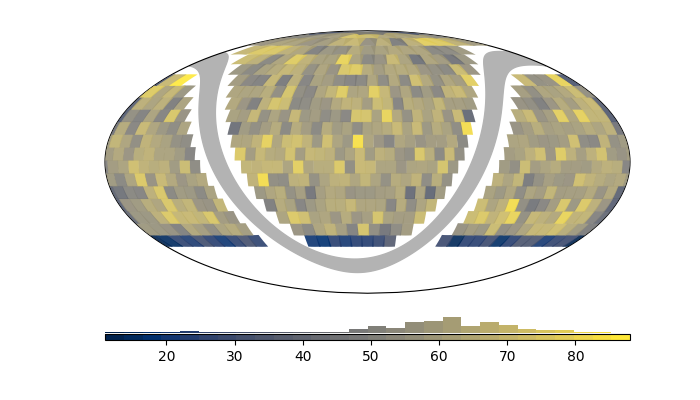ztffields documentation
ztffields is a package made to handle Zwicky Transient Facility (ZTF)
fields system.
ZTF observes using pre-define sets of field idenfitied
with a unique fieldid ; it already exists more than 2000.
The ZTF camera is made of 16 CCDs identified by a unique ccdid
ranging from 1 to 16 (incl.) and each CCD has four amplifier,
definining 4 quadrants defining, in total 64 rcid (16x4) ranging from
0 to 63 (incl.).
ztffields enables to interact with the ztf field system at the
focalplane (whole camera footprint ; 1 polygon), at the ccd (16 polygons) or at the
quadrant (64 polygons) levels.
Sharp start
Get the fieldid that contains a given set of targets
get the fields containing one target
import ztffields
ztffields.radec_to_fieldid( [80, -20] ) # returns a pandas.Series
# result
index_radec
0 1297
0 305
Name: fieldid, dtype: int64
or for a list of targets.
import numpy as np
random = np.random.default_rng(12345)
ras = random.uniform(size=100, low=0, high=360)
decs = random.uniform(size=100, low=0, high=360)
radecs = np.vstack([ras,decs]).T
# input shape (N, 2) or pandas.DataFrame()
fields = ztffields.radec_to_fieldid(radecs) # returns a pandas.Series
fields.head(5)
index_radec
0 1815
0 812
1 1894
1 871
1 872
Name: fieldid, dtype: int64
The index of fields is that of the input coordinates. This matching
is lightning fast. Try !
Select fields for some conditions
The ztffields.get_fieldid function has options to select fields
given some basic conditions such as, grid system (main/secondary)
galactic latitude or milky way extensions. See details in the
function’s docstring. For instance, let’s consider the fields or the
main grid avoiding galactic latitude lower than 10.
good_fields = ztffields.get_fieldid(galb_range=[[-90,-10], [10,90]], grid="main")
Now display the number of target per main grid fields
# Let's generate random sky distribution
size = 40_000
dec_range = [-45, 90]
ra_range=[0,360]
# -> random in the sky
dec_sin_range = np.sin(np.asarray(dec_range)*np.pi/180)
ra = random.uniform(*ra_range, size=size)
dec = np.arcsin( random.uniform(*dec_sin_range, size=size) ) / (np.pi/180)
# build a dataframe structure.
radecs = pandas.DataFrame({"ra":ra, "dec":dec})
# and project to a focalplane shape | try using ccd or quadrant
df = ztffields.radec_to_fieldid(radecs, level="focalplane")
# groupby field id
fieldid_s = df.to_frame().groupby("fieldid").size()
# - and limit to main grid not in the MW
good_fields = ztffields.get_fieldid(galb_range=[[-90,-10],[10,90]], grid="main")
fieldid_s = fieldid_s[fieldid_s.index.isin(good_fields)]
# Display | change the origin to shift the milky way
fig = ztffields.skyplot_fields(fieldid_s, origin=180) # change the

Tweack how to display
# change the origin of the milky way,
# change the projection direction specifying 'geo' in the system (instead of astro by default)
# add a label
# change the colormap
# using a cartopy projection
import cartopy.crs as ccrs
fig = ztffields.skyplot_fields(fieldid_s,
origin=0,
system="geo icrs",
label="number of observations",
cmap="coolwarm",
projection=ccrs.Robinson())



